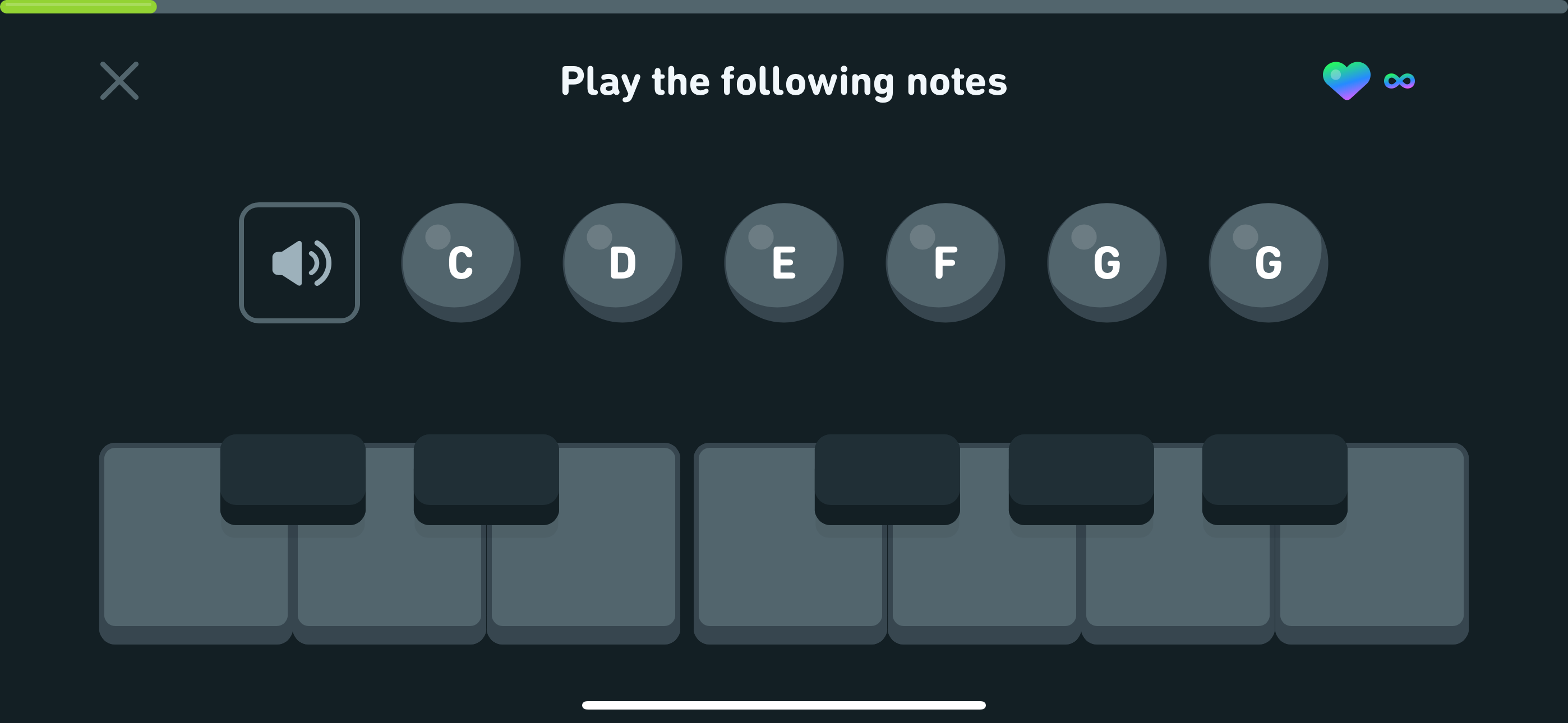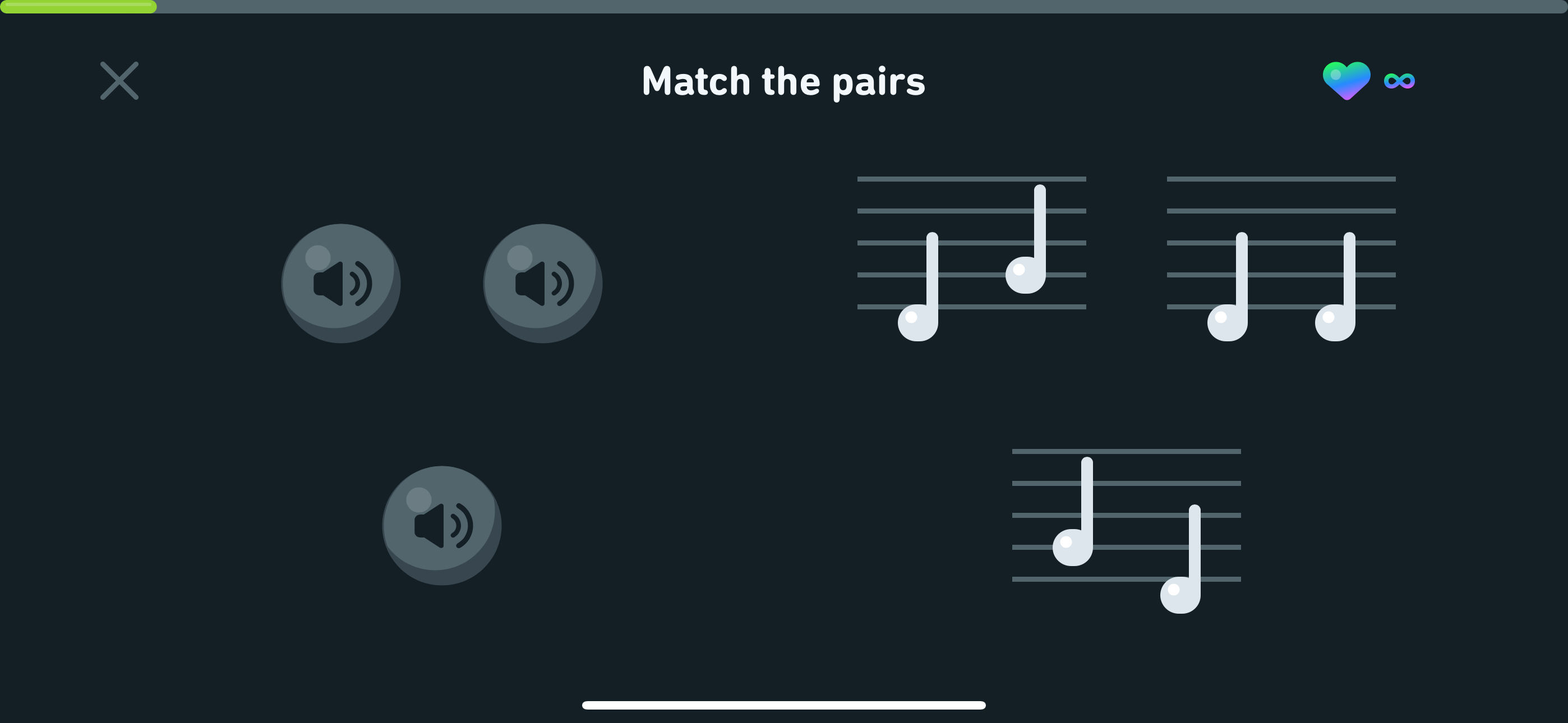I’ve been using Duolingo music for 4 months alongside actual piano lessons - here’s what I found
Dun dun dun DUN!

I started casually learning Hindi and Arabic on Duolingo - and I mean very casually - almost a year ago. 316 days ago, to be exact, if you go off my Duolingo streak. As I was learning, I found myself getting a bit bored with the repetitive lessons, and was only really doing one lesson a day for a while purely to keep my streak going, hoping it would get a bit more interesting the further in I got. I almost abandoned the whole app - until Duolingo Music was announced.
Late last year, Duolingo launched its music learning program, initially geared toward piano. The lessons focus on basic music theory, learning note placement on a keyboard, and building and improving your ability to sight-read music notes. This was incredibly lucky for me, because I had started taking piano lessons just a few months earlier!
It’s been a dream of mine to learn how to play the piano, and while I felt a bit intimidated by the idea of learning an instrument as an adult, I had been thoroughly enjoying myself. I’d been struggling with the theory side of things for a while, though, so I was hopeful that Duolingo Music could help.
Off to a great start!
The lessons start off basic - here’s an image of three piano keys, the C D, and E keys. The first two are labeled, as the course starts with you learning from the middle C onwards, which helpfully reflected the start of my in-person piano lessons. At that point, I felt almost insulted that Duo would throw this at me - but of course, it’s geared towards absolute beginners.
But as I carried on with the module, I realized that we were covering the basics quickly because the app planned to start layering more information on top of the foundational notes, so that by the time you’ve finished the first module, you’ll have about five notes under your belt.

Three lessons into the first module, the app has you playing brief pieces of music on a virtual keyboard to get you to recognize the notes and improve your timing, adding more notes and quicker timings to keep you on your toes.
I found this much more engaging than the language courses, not just because it was fun, but also because I instantly got to put what I was learning into practice - within the Duolingo lessons, but also in my real-life lessons with my tutor. A few weeks into using the app’s new music features, my piano tutor noted how much better I was getting at sight-reading new pieces we covered.
Sign up for breaking news, reviews, opinion, top tech deals, and more.
Can we have actual lessons, please?
Around this time, I entirely swapped over from learning languages on Duolingo to the music course, and within a month or two I was able to skip an entire beginner’s course my tutor and I were going through and head onwards to more challenging pieces.
I rode the high of this accomplishment for quite a while, but after some time I found myself getting frustrated with the stagnation of my progress in the app. I started the process with learning three notes, and now four full months later I’m at… seven notes. Considering that I’m doing the lessons every day, often multiple times a day, that’s not a lot of progress to show for the time investment.

On top of this, once you get out of the introductory phase the lessons start to feel more like a simple rhythm game, with no actual music theory content in sight so far besides ‘identify these notes’. There have been no lessons about chords or scales, octaves, and accidentals. Even when you start playing the more difficult pieces, the only significant thing that changes from piece to piece is the speed you're supposed to play at, but even then it doesn’t come remotely close to what those songs sound like when played on an actual piano.
The foundational blocks at the start of the course can be really helpful, especially if you’ve spent little to no time in any formal music lessons. But once I was a few more sessions deep with my piano tutor, the app quickly fell behind anything we were covering together.
Even now, while I continue to use it to keep my streak going (out of sheer obtusiveness, more than anything else), I no longer find it helpful in my weekly lessons. I’ve opted to buy actual music theory textbooks instead, which have worked wonders compared to anything on the app - in fact, everything I’ve learned from four months on the app was covered in just two pages of my textbook.
Would I recommend it?
If you had asked me early into my Duolingo music journey whether I’d recommend the app, I’d have grabbed your phone and downloaded it for you myself. However, being able to compare the app’s learning experience to my practical music learning has given me a good insight into just how lackluster the app really is.
Even if you skip ahead further in the app’s lesson plans, you’ll find the same kind of boring and repetitive exercises. For the sake of this article, I skipped four modules ahead at the beginning of this week and barely remembered I had skipped ahead until Thursday, when it asked me to ‘revise’ what I had learned previously. I didn’t need to revise what Duolingo taught me, as I’d already learned it myself ages ago.
I skimmed through the Duolingo subreddit to see how other Duolingo enthusiasts felt about the new music lessons, and found that most people are just as lukewarm about them as I am. Many users bemoaned the lack of actual music theory learning beyond identifying notes on a keyboard, and the fact that you can’t play along on a connected electronic instrument instead of just tapping on your screen - a feature some dedicated music-teaching apps do include.

As for what could be done to improve it, I’m not entirely sure what to suggest. Perhaps if Duolingo approached teaching music from a broader theory position rather than trying to make it a piano-specific experience, more people would find it interesting and useful.
It would also mean the lessons would be more intuitive and have a lot more variety - plus, it wouldn’t be restricted to just the people looking to play piano or keyboard. A few people in the Reddit threads I perused who play other instruments wrote about the disappointment they felt when they realized they wouldn't be able to take part in a meaningful way.
Overall, I can’t really pinpoint what’s keeping me going on Duolingo’s music course. It’s probably just because I like the achievement of having a pretty decent streak, but at this point, it’s nothing more than that. Now when I sit down to do a lesson, I do so with the TV on, barely looking down at the screen for more than a few seconds. I used Duolingo music for four months - and I’ve quickly outgrown it.
You might also like...

Muskaan is TechRadar’s UK-based Computing writer. She has always been a passionate writer and has had her creative work published in several literary journals and magazines. Her debut into the writing world was a poem published in The Times of Zambia, on the subject of sunflowers and the insignificance of human existence in comparison.
Growing up in Zambia, Muskaan was fascinated with technology, especially computers, and she's joined TechRadar to write about the latest GPUs, laptops and recently anything AI related. If you've got questions, moral concerns or just an interest in anything ChatGPT or general AI, you're in the right place.
Muskaan also somehow managed to install a game on her work MacBook's Touch Bar, without the IT department finding out (yet).